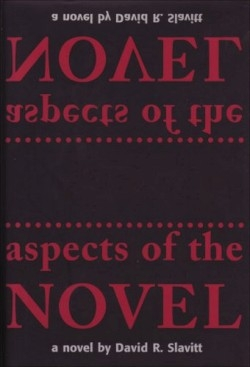Aspects of the Novel
A Novel
Reading this book is like taking a long car ride with a literate, funny, insightful, and clinically depressed companion—who just won’t stop talking. Not that he should stop talking, but, whether the book passes as a joy ride or an excruciating crawl to the last page will depend on how the reader feels about the narrator’s constant musings.
The book takes place over the course of three family events: a graduation, a funeral, and a wedding. It’s a deceptively conventional structure for a novel that questions the very validity of the form—turning it inside out and holding it up to the light to expose the stitching.
“All those tedious descriptions of objects—furniture, china, flatware, clothing (including, every now and then, underwear), in order to suggest a verisimilitude that the author will only squander as he or she manipulates the protagonist into a satisfactory denouement, so that, somehow, the moral conventions of the genre are satisfied: good characters getting at least an approximate kind of reward, while for the wicked one there is some manner of comeuppance,” the narrator declares in the first chapter. “And we are too old for such foolishness. Anyway, I am.”
Having said that, he proceeds with the novel. The difference between this and other novels that wind themselves around big family events is that the narrator doesn’t really participate in these gatherings. He shows up, but stays, mentally at least, isolated within his own overactive mind.
As he sits at his son’s law school graduation, his thoughts speed through interfaith ministers, a fight with his sister over salmon mousse, Lazarus, and genocide in Bosnia and Rwanda—and that’s just during the applause. The narrator twists words and allusions into knots like straws, as if to see just how far they’ll bend. These
contortions, though, are never really mere sport, but a way of revealing surprising truths—about family, death, the banality of social customs. All of these observations are shaped by the vise of his depression.
The author has written sixteen novels, and a total of seventy works including fiction, poetry and translations of poetry, and dramas. He teaches literature and writing at Bennington College. His novel’s title comes from E.M. Forster’s classic work of the same name. That groundbreaking examination of the form is a text that Slavitt no doubt knows well and has assigned to his students.
Both sad and illuminating, this novel makes a fitting homage to Forster’s study, proving in its own quirky way the enduring power of those aspects.
Reviewed by
Karen Holt
Disclosure: This article is not an endorsement, but a review. The publisher of this book provided free copies of the book to have their book reviewed by a professional reviewer. No fee was paid by the publisher for this review. Foreword Reviews only recommends books that we love. Foreword Magazine, Inc. is disclosing this in accordance with the Federal Trade Commission’s 16 CFR, Part 255.

